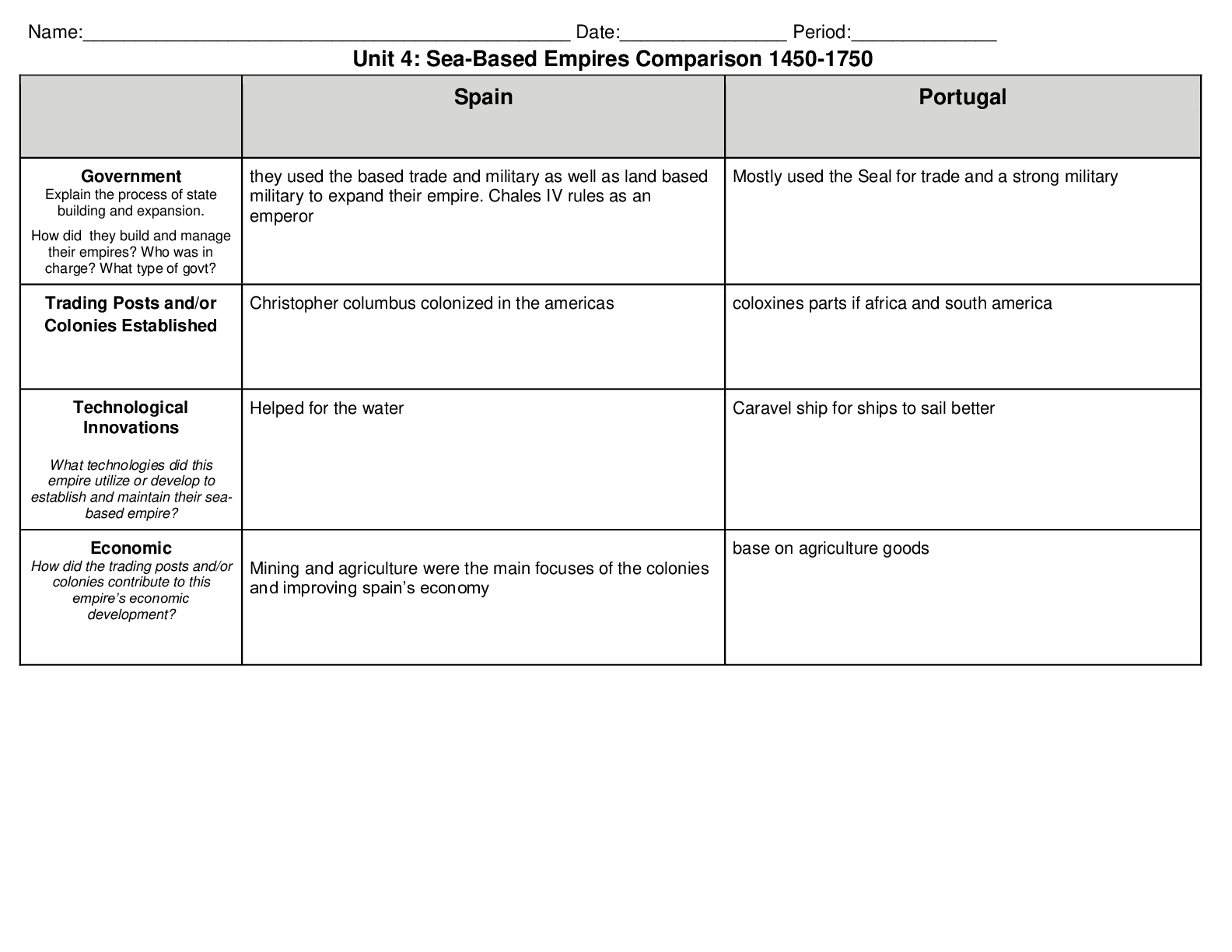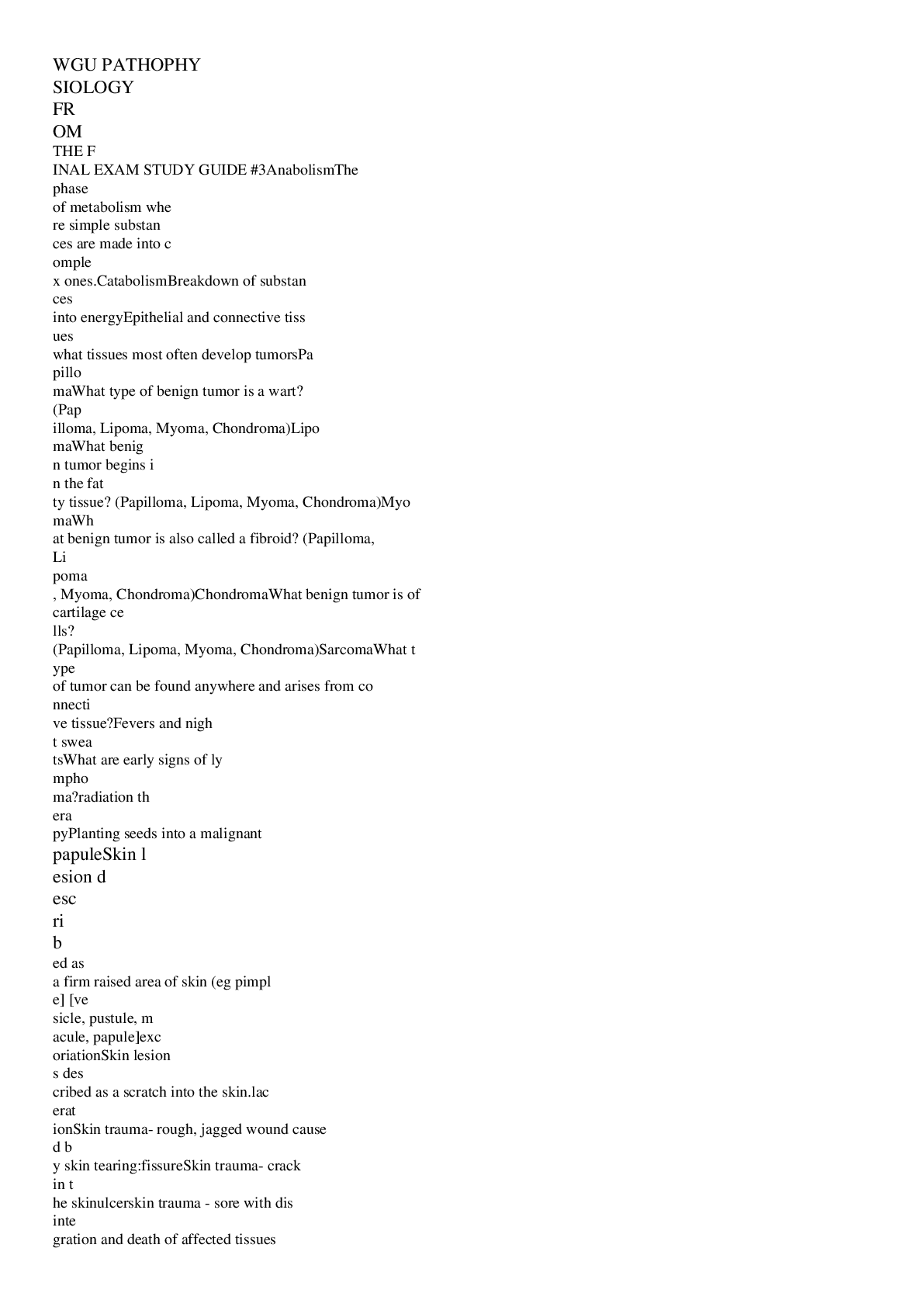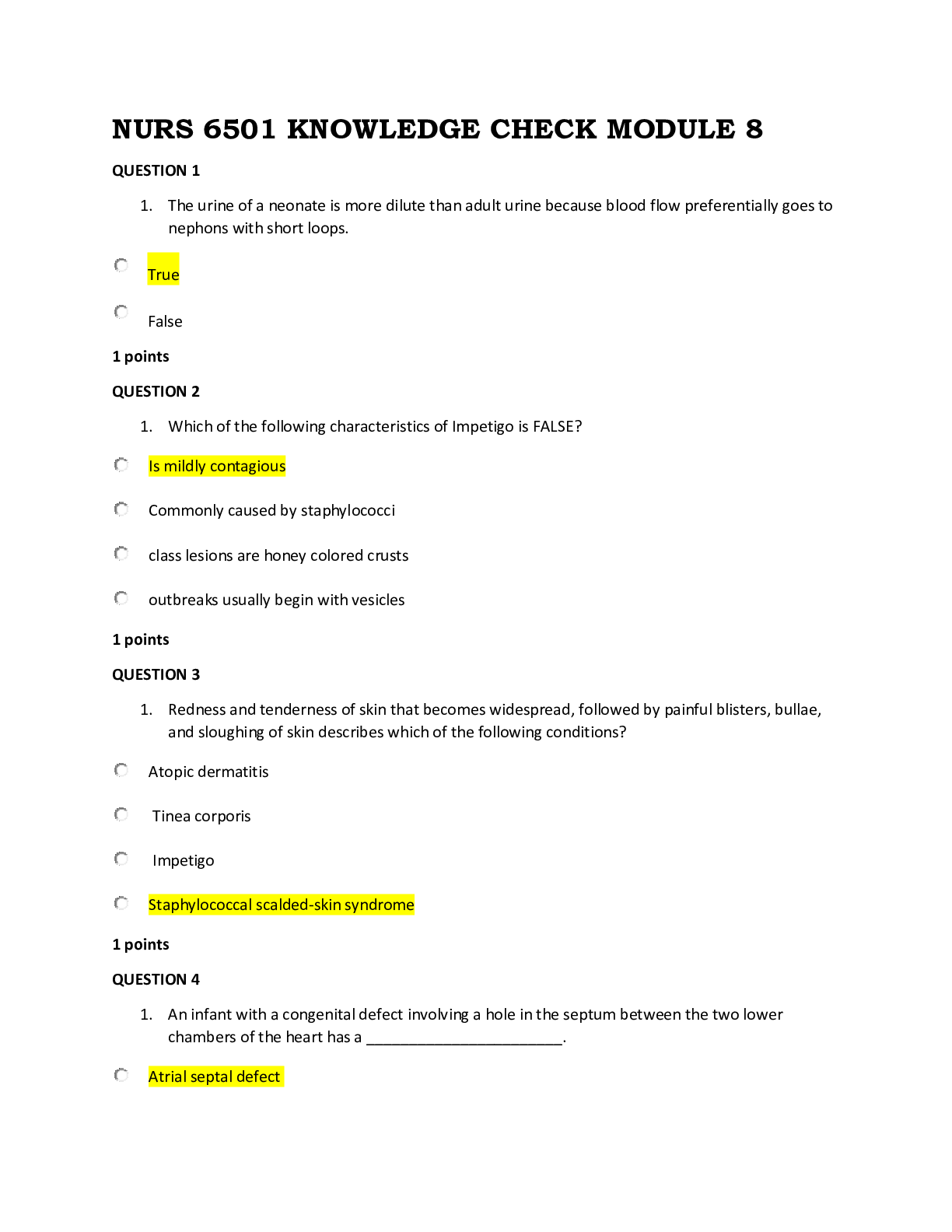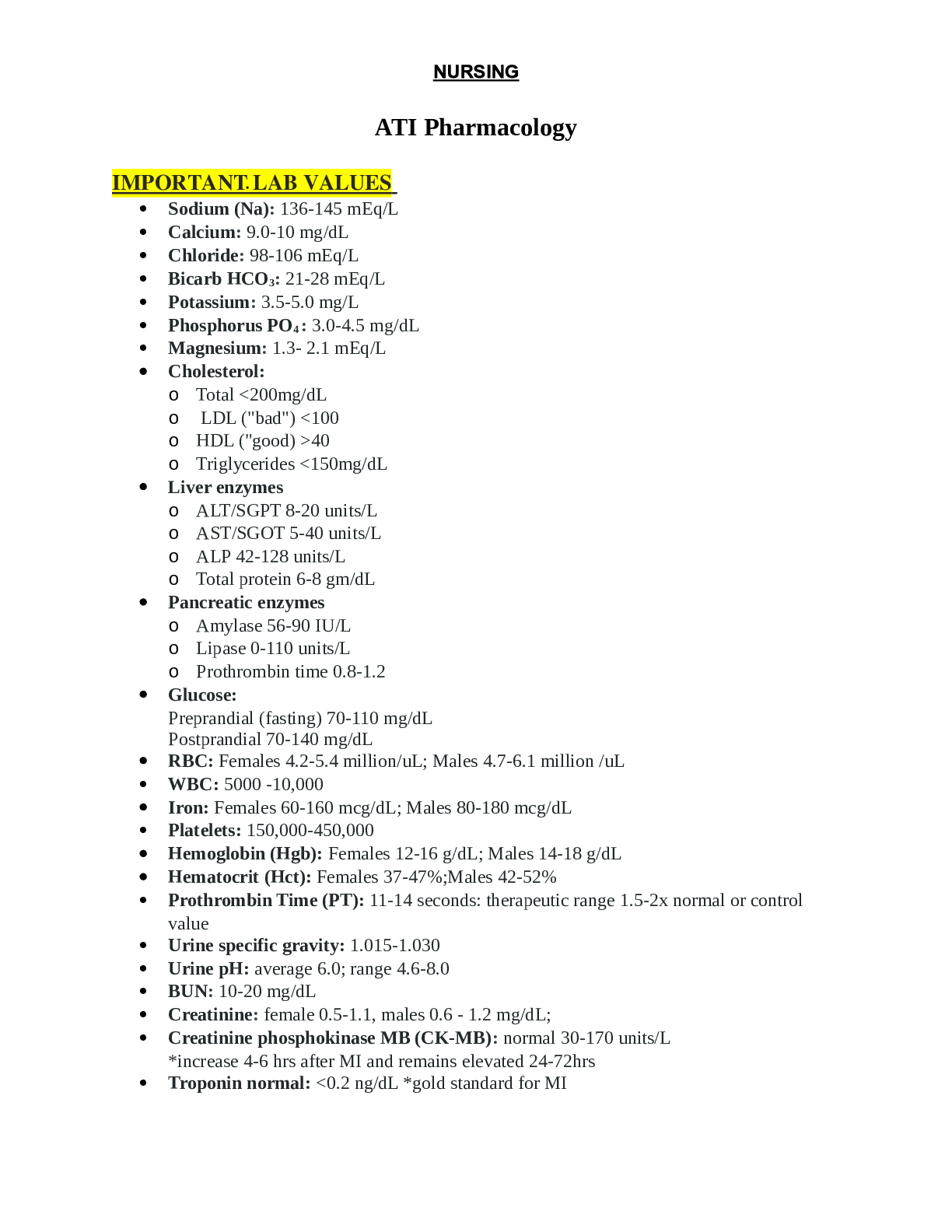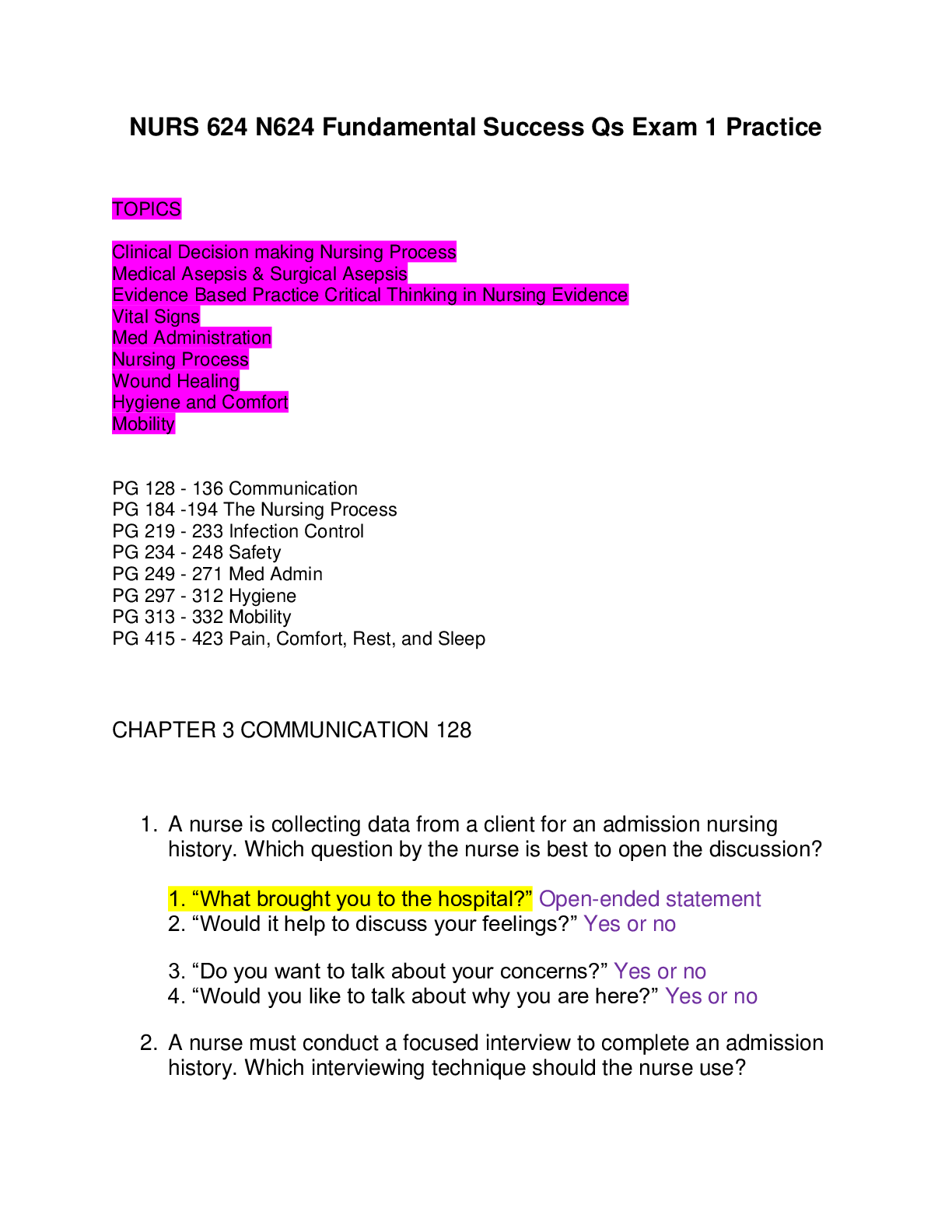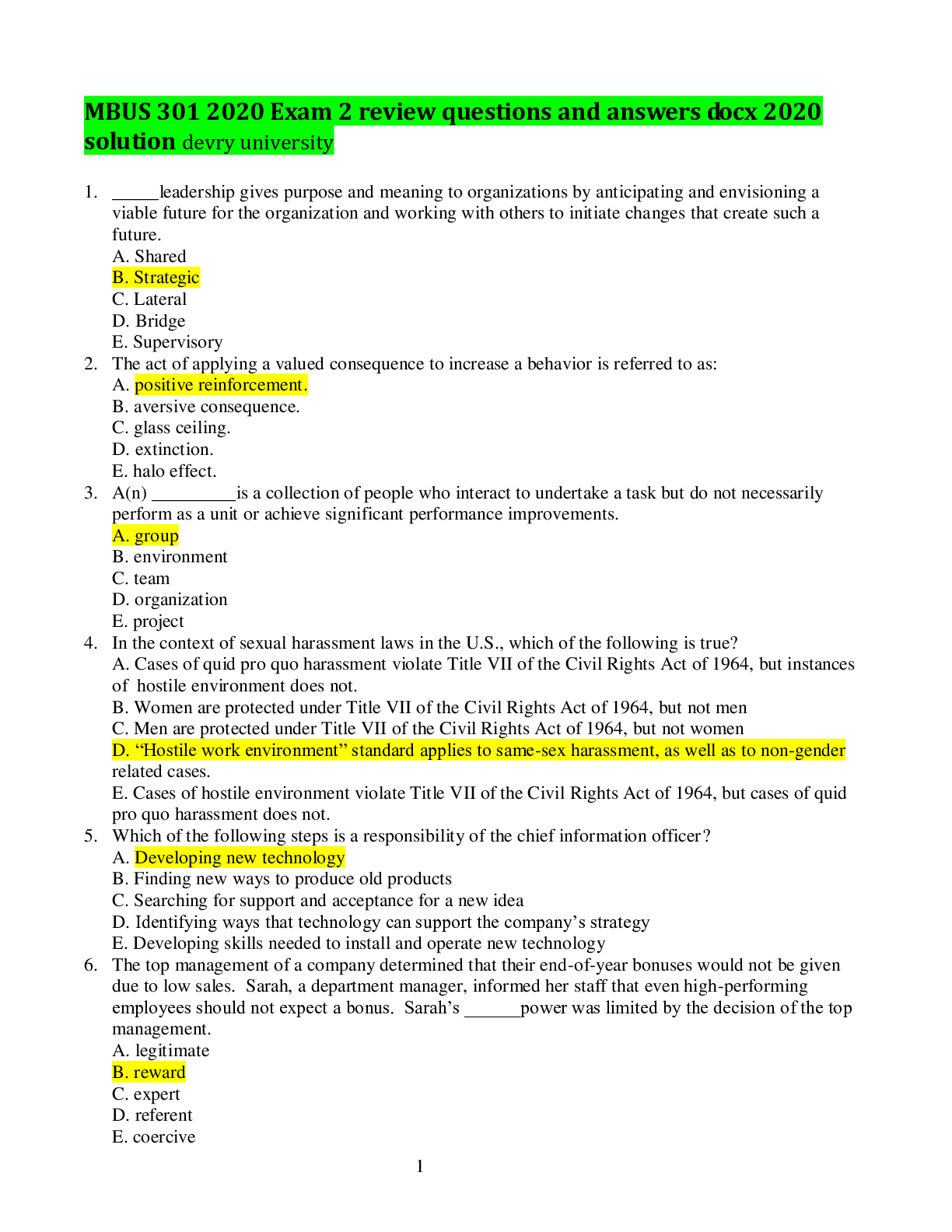*NURSING > STUDY GUIDE > NR327 Exam 2 Review Questions #1 (Postpartum Physiologic Adaptations & Nursing Care (All)
NR327 Exam 2 Review Questions #1 (Postpartum Physiologic Adaptations & Nursing Care
Document Content and Description Below
2/5/2019 (1) ✅ NR327 Exam 2 Review Questions #1 (Postpartum Physiologic Adaptations & Nursing Care (17)) https://docs.google.com/forms/d/1-RrFDe__2nulVG0p7F6jOgPe02SslXbH-cFwO9t4FSc/edit 1/17 (1) ... ✅ NR327 Exam 2 Review Questions #1 (Postpartum Physiologic Adaptations & Nursing Care (17)) * Required 1. Email address * Postpartum Physiologic Adaptations Part 1 2. 1. A nurse is performing a fundal assessment for a client in her second postpartum day and observes the client’s perineal pad for lochia. She notes the pad to be saturated approximately 12 cm with lochia that is bright red in color and contains small clots. The nurse knows that this finding is: * Mark only one oval. A. moderate lochia rubra. B. excessive lochia rubra. C. light lochia rubra. D. scant lochia serosa.2/5/2019 (1) ✅ NR327 Exam 2 Review Questions #1 (Postpartum Physiologic Adaptations & Nursing Care (17)) https://docs.google.com/forms/d/1-RrFDe__2nulVG0p7F6jOgPe02SslXbH-cFwO9t4FSc/edit 2/17 3. 2. During ambulation to the bathroom, a postpartum client experiences a gush of dark red blood that soon stops. On assessment, a nurse finds the client’s uterus to be firm and midline and at the level of the umbilicus. The nurse interprets this finding as: * Mark only one oval. A. evidence of a possible vaginal hematoma. B. an indication of a cervical or perineal laceration. C. a normal postural discharge of lochia. D. abnormally excessive lochia rubra flow. 4. 3. A nurse is assessing a postpartum client for fundal height, location, and consistency. The fundus is found to be displaced laterally to the right, and there is uterine atony. Which of the following is the cause of the uterine atony? * Mark only one oval. A. Poor involution B. Urinary retention C. Hemorrhage D. Infection 5. 4. A nurse is completing postpartum discharge teaching to a client who had no immunity to varicella and was given varicella vaccine. Which of the following statements by the client indicates understanding of the teaching? * Mark only one oval. A. “I will need to use contraception for 3 months before considering pregnancy.” B. “I need a second vaccination at my postpartum visit.” C. “I was given the vaccine because my baby is O-positive.” D. “I will be tested in 3 months to see if I have developed immunity.” 6. 5. A nurse is caring for a client who is 1 hr following a vaginal birth and experiencing uncontrollable shaking. The nurse should understand that the shaking is due to which of the following? (Select all that apply.) * Check all that apply. A. A change in body fluids B. The metabolic effort of labor C. Diaphoresis D. A decrease in body temperature E. A decrease in prolactin levels 7. 6. When checking a woman's fundus 24 hours after the cesarean birth of her first baby, the nurse finds her fundus at the level of her umbilicus, firm, and in the midline. The appropriate nursing action related to this assessment is to: * Mark only one oval. a. document the normal assessment b. determine when she last urinated c. limit her intake of oral fluids d. massage her fundus vigorously2/5/2019 (1) ✅ NR327 Exam 2 Review Questions #1 (Postpartum Physiologic Adaptations & Nursing Care (17)) https://docs.google.com/forms/d/1-RrFDe__2nulVG0p7F6jOgPe02SslXbH-cFwO9t4FSc/edit 3/17 8. 7. A woman who is 18 hours postpartum says she is having "hot flashes" and "swears all the time". The appropriate nursing response is to: * Mark only one oval. a. report her signs and symptoms of hypovolemic shock b. tell her that her body is getting rid of unneeded fluid c. notify her nurse-midwife that she may have an infection d. limit her intake of caffeine-containing fluids 9. 8. A woman who is 3 hours postpartum has had difficulty urinating. She finally urinates 100 ml. The initial nursing action is to: * Mark only one oval. a. insert an indwelling catheter b. have her drink additional fluids c. assess the height of her fundus d. chart the urination amount 10. 9. When teaching the postpartum woman about Peripads, the nurse should tell her that: * Mark only one oval. a. she can change to tampons when the initial perineal soreness goes away b. pads having cold packs within them usually hold more lochia than regular pads c. blood-soaked pads must be returned in a plastic bag to the hospital after discharge d. the pads should be applied and removed in a front- to- back direction 11. 10. A young mother is excited about her first baby. Choose the best teaching to help her obtain adequate rest after discharge: * Mark only one oval. a. plan to sleep or rest any time the infant sleeps b. do all housecleaning while the infant sleeps c. cook several meals at once and freeze for later use d. tell family and friends not to visit for the 1st month 12. 11. Choose the best independent nursing action to aid episiotomy healing in the woman who is 24 hours postpartum: * Mark only one oval. a. antibiotic cream applications to the area b. warm sitz baths taken four times per day c. maintaining cold packs to the area at all times d. checking the leukocyte level2/5/2019 (1) ✅ NR327 Exam 2 Review Questions #1 (Postpartum Physiologic Adaptations & Nursing Care (17)) https://docs.google.com/forms/d/1-RrFDe__2nulVG0p7F6jOgPe02SslXbH-cFwO9t4FSc/edit 4/17 13. 12. To prevent breast engorgement, the nurse should teach the non-breastfeeding postpartum woman to: * Mark only one oval. a. maintain loose-fitting clothing over her breasts b. pump the breasts briefly if they become painful c. limit fluid intake to suppress milk production d. wear a well-fitting bra or breast binder constantly 14. 13. A woman who is 4 hours postpartum ambulates to the bathroom and suddenly has a large gush of lochia rubra. The nurse's first action should be to: * Mark only one oval. a. determine whether the bleeding slows to normal or remains large b. observe vital signs for signs of hypovolemic shock c. check to see what her previous lochia flow has been d. identify the type of pain relief that was given when she was in labor 15. 14. To help the postpartum woman to avoid constipation, the nurse should teach her to: * Mark only one oval. a. avoid intake of foods such as milk, cheese, or yogurt b. take a laxative for the first 3 postpartum days c. drink at least 2500 ml of non-caffeinated fluids daily d. limit her walking until the episiotomy is freely healed 16. 15. Choose the sign or symptom that the new mother should be taught to report: * Mark only one oval. a. occasional uterine cramping when the infant nurses b. oral temp that is 37.2d C (99dF) in the morning c. descent of the fundus one finger-breadth each day d. reappearance of red lochia after it changes to serous 17. 16. Twelve hours after birth, a mother lies in bed resting. Although she will be discharged in another 12 hours, she does not ask about her baby or provide any care. What is the probable reason for her behavior? * Mark only one oval. a. she is still in the taking-in phase of maternal adaptation b. she shows behaviors that may lead to postpartum depression c. she is still affected by medications given during labor d. she may be dissatisfied with some aspect of the newborn2/5/2019 (1) ✅ NR327 Exam 2 Review Questions #1 (Postpartum Physiologic Adaptations & Nursing Care (17)) https://docs.google.com/forms/d/1-RrFDe__2nulVG0p7F6jOgPe02SslXbH-cFwO9t4FSc/edit 5/17 18. 17. A new father is reluctant to "spoil" his newborn when she cries by picking her up. The best nursing response is to: * Mark only one oval. a. teach him that she will eventually stop crying if he waits b. take the baby to the nursery to allow the parents to rest c. pick the baby up and rock her until she sleeps again d. tell the father that the baby cries to communicate a need 19. 18. A newborn is rooming in with his teenage mother, who is watching TV. The nurse notes that the baby is awake and quiet. The best nursing action is to: * Mark only one oval. a. Pick the baby up and point out his alert behaviors to the mother. b. Tell the mother to pick up her baby and talk with him while he is awake. c. Focus care on the mother, rather than the infant so she can recuperate. d. Encourage the mother to feed the infant before he begins crying. 20. 19. The best nursing encouragement for parents to care for their infant is to: * Mark only one oval. a. stay out of the room for as long as possible b. have the grandmother nearby as a backup c. give positive feedback when they provide care d. correct their performance whenever they make a mistake 21. 20. The nurse places one hand about the symphysis pubis during uterine massage to: * Mark only one oval. a. Make the massage more comfortable for the woman b. Increase the effectiveness of the procedure c. Help prevent the uterus from inverting d. Help determine the firmness of the uterus 22. 21. The nurse notes that a woman has excess lochia 2 hours after the vaginal birth of an 8-lb baby. The priority nursing action is to: * Mark only one oval. a. Catheterize her to check urine output b. Check her blood pressure, pulse, and respirations c. Assess the firmness of her uterus d. Notify her physician or nurse-midwife2/5/2019 (1) ✅ NR327 Exam 2 Review Questions #1 (Postpartum Physiologic Adaptations & Nursing Care (17)) https://docs.google.com/forms/d/1-RrFDe__2nulVG0p7F6jOgPe02SslXbH-cFwO9t4FSc/edit 6/17 23. 22. Choose the signs and symptoms that suggest postpartum hemorrhage causing a hematoma. * Mark only one oval. a. Rectal pain accompanied by a rising pulse b. Cramping accompanied by a steady trickle of blood c. Soft uterine fundus and falling blood pressure d. Heavy lochia accompanied by tachypnea and dyspnea 24. 23. One hour after a woman gives birth vaginally, the nurse notes that her fundus is firm, 2 fingerbreadths above the umbilicus, and deviated to the right. Lochia rubra is moderate. Her perineum is slightly edematous, with no bruising; an ice pack is in place. The priority nursing action is to * Mark only one oval. a. Chart these expected normal assessments b. Have the woman empty her bladder c. Remove the perineal ice pack for 20 minutes d. Increase the rate of the oxytocin infusion 25. 24. What drug should be readily available when a woman is receiving heparin therapy? * Mark only one oval. a. Vitamin K b. Methylergonovine c. Ferrous sulfate d. Protamine sulfate 26. 25. The nurse's initial response if a pulmonary embolism is suspected should be to: * Mark only one oval. a. Start a second IV line and prepare for transfusion b. Raise the HOB and administer oxygen c. Insert a catheter to monitor urine output d. Lower the HOB and elevate the legs Postpartum Physiologic Adaptations Part 2 27. 26. A woman has an 8-lb 9-oz baby after an 18 hour labor that required a vacuum extraction. Her membranes have been ruptured for 15 hours. Based on these facts, client teaching should emphasize: * Mark only one oval. a. Reporting foul-smelling lochia and fever b. Delaying intercourse for at least 6 weeks c. Eating a diet that is high in iron and vitamin C d. Losing weight over at least a 6-month period2/5/2019 (1) ✅ NR327 Exam 2 Review Questions #1 (Postpartum Physiologic Adaptations & Nursing Care (17)) https://docs.google.com/forms/d/1-RrFDe__2nulVG0p7F6jOgPe02SslXbH-cFwO9t4FSc/edit 7/17 28. 27. Postpartum teaching related to urinary health should emphasize: * Mark only one oval. a. Drinking any type of fluid whenever thirsty b. Allowing the bladder to fill to promote emptying c. Cleansing the perineum in a front-to-back direction d. Eating two servings of acidic fruits or vegetables each day 29. 28. A new father tells a nurse friend that his wife is agitated & acting in a bizarre fashion. She says that she hears voices. Her baby is 2 weeks old. The father is concerned about the care the mother is giving the baby. The nurse should: * Mark only one oval. a. Tell the father that this is severe postpartum blue and will pass in a few days if he shows enough support b. Suggest that the father try talking to his wife to find out what is bothering her about being a new mother c. Explain that the mother will probably need psychotherapy and refer him to support groups d. Tell the father to call the physician immediately and not to leave the woman alone with the baby 30. 29. A breastfeeding woman develops mastitis. She tells the nurse that she will feed her baby formula instead of breastfeeding until the infection is healed. The best nursing response is that: * Mark only one oval. a. Emptying the breast is important to prevent an abscess b. A tight breast binder or bra will help reduce engorgement c. She should continue to drink extra fluids while weaning d. Breastfeeding can continue when her temperature is normal 31. 30. A woman tells you she has been teary for most of the 2 weeks since the birth of her baby. Although the infant appears to be cared for appropriately, the mother states that she feels too tired to spend as much time with him as she should. She has lost her appetite and cannot sleep at night. She has been too ashamed to tell anyone before now. The nurse's best response is to: * Mark only one oval. a. Tell her that this is normal postpartum blues and she will get over it in a few more days b. Suggest that she get help to care for the baby and that with more rest she will feel fine c. Listen to her feelings carefully and then acknowledge that something is wrong d. Suggest that she spend time away from the baby to rest from the constant infant care 32. 31. Immediately after delivery the nurse can anticipate the fundus to be located: * Mark only one oval. a. 2 cm above the umbilicus. b. 1 cm below the umbilicus. c. midway between the symphysis pubis and umbilicus. d. at the umbilicus2/5/2019 (1) ✅ NR327 Exam 2 Review Questions #1 (Postpartum Physiologic Adaptations & Nursing Care (17)) https://docs.google.com/forms/d/1-RrFDe__2nulVG0p7F6jOgPe02SslXbH-cFwO9t4FSc/edit 8/17 33. 32. When reading the postpartum chart the nurse notices that the client's fundus is recorded as "u+1". The nurse understands that this means the fundus is: * Mark only one oval. a. 1 cm above the umbilicus. b. 1 cm below the umbilicus. c. 1 inch above the umbilicus. d. 1 inch below the umbilicus. 34. 33. During the second postpartum day, a woman asks the nurse, "Why are my afterpains so much worse this time than after the birth of my other child?" The best answer by the nurse would be: * Mark only one oval. a. "Most women forget how strong the afterpains can be." b. "They should not be strong with you because you are breastfeeding." c. "You should not be feeling the pains now; I will notify the physician for you." d. "Afterpains are more severe for women that have already had babies." 35. 34. The nurse is assessing the client's vaginal discharge. It is red and has about a 2-inch stain on the peripad. The nurse will record this finding as: * Mark only one oval. a. light amount of lochia rubra. b. scant amount of lochia alba. c. moderate amount of lochia rubra. d. heavy amount of lochia alba. 36. 35. The new mother is complaining of pain at the episiotomy site; however, because she is breastfeeding she does not want any medication. What other alternatives can the nurse offer this mother to help relieve the pain? * Mark only one oval. a. Ambulation b. Topical anesthetics c. Hot fluids to drink d. Stool softeners 37. 36. A mother that is 3 days postpartum calls the clinic and complains of "night sweats." She is afraid that she is going into early menopause. The nurse should base her answer on the fact that: * Mark only one oval. a. birth may put some women into early menopause; an appointment is needed to have this checked out. b. night sweats may be an indication of many other problems; an appointment is needed to assess the problem. c. diaphoresis is normal during the postpartum period, and comfort measures can be suggested to the mother. d. diaphoresis is normal only if the mother is breastfeeding.2/5/2019 (1) ✅ NR327 Exam 2 Review Questions #1 (Postpartum Physiologic Adaptations & Nursing Care (17)) https://docs.google.com/forms/d/1-RrFDe__2nulVG0p7F6jOgPe02SslXbH-cFwO9t4FSc/edit 9/17 38. 37. On the first day postpartum a client's white blood cell count is 25,000/mm3. The nurse's next action should be to: * Mark only one oval. a. notify the physician for an antibiotic order. b. assess the client's temperature and blood pressure. c. request the count be repeated. d. note the results in the chart. 39. 38. Constipation is a common problem during the postpartum period. Select all of the reasons for constipation during this period. * Check all that apply. a. Diminished bowel tone b. Overhydration during labor c. Episiotomy that causes the fear of pain with elimination d. Iron supplementation e. Some pain medications 40. 39. One nursing measure that can help prevent postpartum hemorrhage and urinary tract infections is: * Mark only one oval. a. forcing fluids. b. perineal care. c. encouraging voiding every 2 to 3 hours. d. encouraging the use of stool softeners. 41. 40. While doing client teaching the woman tells the nurse, "I don't have to worry about contraception because I am breastfeeding." The nurse should base her answer on the fact that: * Mark only one oval. a. Breastfeeding can be considered a reliable system of birth control. b. Breastfeeding can be used as a contraceptive method if strict guidelines are followed through. c. Breastfeeding is not a reliable contraceptive method. 42. 41. A woman was admitted to the ED with her newborn baby. The baby was born 4 days ago at home. The woman had no prenatal care. The nurse is assessing the lab work and sees that the mother has O-negative blood type and the baby is O positive and the Coombs test shows the mother is not sensitized to the positive blood. The nurse's next action should be: * Mark only one oval. a. order Rh(D) immune globulin to be given to the mother. b. order Rh(D) immune globulin to be given to the baby. c. record the findings of the lab work and not plan on any further action at this time.2/5/2019 (1) ✅ NR327 Exam 2 Review Questions #1 (Postpartum Physiologic Adaptations & Nursing Care (17)) https://docs.google.com/forms/d/1-RrFDe__2nulVG0p7F6jOgPe02SslXbH-cFwO9t4FSc/edit 10/17 43. 42. The first time a woman ambulates after the birth of the newborn, she has a nursing diagnosis of Risk for Injury. This is due to the: * Mark only one oval. a. risk for developing orthostatic hypotension. b. development of bradycardia. c. increase in cardiac output. d. increase in circulatory volume. 44. 43. When assessing a woman that gave birth 2 hours ago, the nurse notices a constant trickle of lochia. The uterus is well contracted. The next nursing action should be to: * Mark only one oval. a. massage the fundus. b. continue to monitor. c. notify the physician. d. assess the blood pressure and pulse for changes. 45. 44. When assessing the perineum, episiotomy site, or surgical site, the nurse should assess for specific signs. Select all of the signs that are appropriate when assessing a surgical site. * Check all that apply. a. Redness b. Edema c. Ecchymosis d. Discharge e. Asymmetry 46. 45. During the early post-cesarean section phase it is important for the woman to turn, cough, and deep breathe. The rationale for this is to prevent: * Mark only one oval. a. pooling of secretions in the airway. b. thrombus formation in the lower legs. c. gas formation in the intestinal tract. d. urinary retention. 47. 46. The postpartum woman has a blood pressure of 150/90, pulse of 72 beats per minute, and respirations of 14 breaths per minute. She continues to bleed heavily. The order states she may have either methylergonovine (Methergine) 0.2 mg IM or oxytocin (Pitocin) 10 units IM for heavy bleeding. The nurse should administer which medication? * Mark only one oval. a. Methylergonovine b. Oxytocin2/5/2019 (1) ✅ NR327 Exam 2 Review Questions #1 (Postpartum Physiologic Adaptations & Nursing Care (17)) https://docs.google.com/forms/d/1-RrFDe__2nulVG0p7F6jOgPe02SslXbH-cFwO9t4FSc/edit 11/17 48. 47. As part of the postpartum assessment, the nurse examines the breasts of a primiparous breastfeeding woman who is 1 day postpartum. An expected finding would be: * Mark only one oval. a. soft, nontender; colostrum is present. b. leakage of milk at let-down. c. swollen, warm, and tender upon palpation. d. a few blisters and a bruise on each areola. 49. 48. During which phase of maternal adjustment will the mother relinquish the baby of her fantasies and accept the real baby? * Mark only one oval. a. Letting-go b. Taking-in c. Taking-on d. Taking-hold 50. 49. To promote bonding and attachment immediately after birth, which action should the nurse take? * Mark only one oval. a. Assist the mother in feeding her baby. b. Allow the mother quiet time with her infant. c. Teach the mother about the concepts of bonding and attachment. d. Assist the mother in assuming an en face position with her newborn. 51. 50. A postpartum patient calls the clinic and reports to the nurse feelings of fatigue, tearfulness, and anxiety. What is the nurse's best response? * Mark only one oval. a. "When did these symptoms begin?" b. "Sounds like normal postpartum depression." c. "Are you having trouble getting enough sleep?" d. "Are you able to get out of bed and provide care for your baby?" Postpartum Physiologic Adaptations Part 3 52. 51. Which are nursing measures that can promote parent-infant bonding and attachment? (Select all that apply.) * Check all that apply. a. Provide comfort and ample time for rest. b. Keep the baby wrapped to avoid cold stress. c. Position the infant face to face with the mother. d. Point out the characteristics of the infant in a positive way. e. Limit the amount of modeling so the mother doesn't feel insecure.2/5/2019 (1) ✅ NR327 Exam 2 Review Questions #1 (Postpartum Physiologic Adaptations & Nursing Care (17)) https://docs.google.com/forms/d/1-RrFDe__2nulVG0p7F6jOgPe02SslXbH-cFwO9t4FSc/edit 12/17 53. 52. The new mother comments that the newborn "has his father's eyes." The nurse recognizes this as: * Mark only one oval. a. Part of the bonding process termed claiming. b. The mother trying to find signs of the baby's paternity. c. The mother trying to include the father in the bonding process. d. Part of the letting-go phase of maternal adaptation. 54. 53. A new father of 1 day expresses concern to the nurse that his wife, who is normally very independent, is asking him to make all the decisions. The nurse can best explain this as a(n): * Mark only one oval. a. Normal occurrence because the mother is in pain. b. Abnormal occurrence that needs to be assessed further. c. Normal occurrence because the mother is in the taking-in phase. d. Normal occurrence because the mother is frustrated with the care of the newborn. 55. 54. The day after giving birth, the woman complains that she did not lose all the weight she had gained during the pregnancy. The nurse can best respond to the mother with the knowledge that: * Mark only one oval. a. She has lost the most of the weight and the rest will be gone within 1 week. b. She has lost some of the weight and the rest will slowly disappear within 6 weeks. c. It will take about 6 to 12 months for all the weight gained with the pregnancy to disappear. d. Most women do not lose all the weight gained with each pregnancy. 56. 55. The home care nurse is visiting a new mother who delivered 1 week ago. The mother complains about not being able to sleep and that she is tired and cries easily. The best response by the nurse would be: * Mark only one oval. a. "Having a baby is difficult; it will be a long time before you get a good night's sleep." b. "Maybe your mother can come in and help you out." c. "It is normal for this to happen and should go away in 2 weeks. It must be very difficult for you to feel this way with a new baby." d. "The hospital nurses must not have taught you enough information about the changes you will experience during these first 6 weeks."2/5/2019 (1) ✅ NR327 Exam 2 Review Questions #1 (Postpartum Physiologic Adaptations & Nursing Care (17)) https://docs.google.com/forms/d/1-RrFDe__2nulVG0p7F6jOgPe02SslXbH-cFwO9t4FSc/edit 13/17 57. 56. The new parents express concern that their 4-year-old son is jealous of the new baby. They are planning on going home tomorrow and are not sure how the preschooler will react when they bring the baby home. Which of the following suggestions by the nurse will be most helpful? * Mark only one oval. a. Be aware that the child may regress to an earlier stage. b. Have the mother go into the house alone and spend time with the child before the father brings the baby in. c. Have the child stay with a grandparent until the parents adjust to the new baby. d. Tell the child that he is a "big boy" now and doesn't need his crib so the new baby will be using it for a while. 58. 57. When making a visit to the home of a postpartum woman 1 week after birth, the nurse should recognize that the woman would characteristically: * Mark only one oval. a. Express a strong need to review events and her behavior during the process of labor and birth. b. Exhibit a reduced attention span, limiting readiness to learn. c. Attempt to meet the needs of the infant and is eager to learn about infant care. d. Have reestablished her role as a spouse and partner. 59. 58. Four hours after a difficult labor and birth, a primiparous woman refuses to feed her baby, stating that she is too tired and just wants to sleep. The nurse should: * Mark only one oval. a. Tell the woman she can rest after she feeds her baby. b. Recognize this as a behavior of the taking-hold stage. c. Record the behavior as ineffective maternal-newborn attachment. d. Take the baby back to the nursery, reassuring the woman that her rest is a priority at this time. 60. 59. A primiparous woman is in the taking-in stage of psychosocial recovery and adjustment following birth. The nurse, recognizing women's needs during this stage, should: * Mark only one oval. a. Foster an active role in the baby's care. b. Provide time for the mother to reflect on the events of the childbirth. c. Recognize the woman's limited attention span by giving her written materials to read when she gets home rather than doing a teaching session now. d. Promote maternal independence by encouraging her to meet her own hygiene and comfort needs.2/5/2019 (1) ✅ NR327 Exam 2 Review Questions #1 (Postpartum Physiologic Adaptations & Nursing Care (17)) https://docs.google.com/forms/d/1-RrFDe__2nulVG0p7F6jOgPe02SslXbH-cFwO9t4FSc/edit 14/17 61. 60. To promote bonding during the first hour after birth, the nurse can do which of the following? (Select all that apply). * Check all that apply. a. Delay procedures if appropriate. b. Allow the father to hold the newborn. c. Demonstrate proper bottle feeding techniques. d. Allow as much contact with the newborn as possible. e. Use the time to do parent teaching on newborn characteristics. 62. 61. Nursing measures to promote bonding and attachment include which of the following? (Select all that apply). * Check all that apply. a. Assist the parents in unwrapping the baby to inspect. b. Point out that the infant grasping the mother's or father's finger is a natural reflex. c. Explain the physical changes in the newborn, such as molding, as being normal. d. Encourage the mother to let the infant stay in the nursery as much as possible so the mother can rest. e. Position the infant in a face to face position with the mother. 63. 62. Which client would be at the highest risk for postpartum hemorrhage? * Mark only one oval. a. Primigravida who delivered a 6 lb, 3 oz girl b. Gravida 2 who delivered a 8 lb, 6 oz boy c. Gravida 3 who delivered twins, 5 lb, 3 oz and 4 lb, 2 oz. d. Gravida 3 who delivered a 4 lb, 3 oz boy 64. 63. Which newly delivered mother with an unassisted birth is at greatest risk for lacerations of the cervical area of vagina? * Mark only one oval. a. Primigravida with 10-hour labor, 1-hour pushing stage b. Gravida 2 with an 8-hour labor, 30-minute pushing stage c. Gravida 2 with a 1-hour labor, 10-minute pushing stage d. Gravida 3 with a 5-hour labor, 30-minute pushing stage 65. 64. Late postpartum hemorrhage occurs usually at 7 to 14 days after birth. The nurse should teach the new mother about to be discharged to notify the health care provider if the: * Mark only one oval. a. Lochia become pink or brown. b. Uterine cramping (after pains) decreases. c. Lochia rubra continues and increases. d. Lochia stops completely.2/5/2019 (1) ✅ NR327 Exam 2 Review Questions #1 (Postpartum Physiologic Adaptations & Nursing Care (17)) https://docs.google.com/forms/d/1-RrFDe__2nulVG0p7F6jOgPe02SslXbH-cFwO9t4FSc/edit 15/17 66. 65. When checking the fundus on a mother who delivered 1 hour ago, the nurse notices that it is 3 cm above the umbilicus, displaced to the right, and slightly boggy. The nurse should massage the fundus until firm and then * Mark only one oval. a. Assist the mother to empty her bladder. b. Assist the mother to walk around in the room. c. Reassess the fundus in 5 minutes. d. Monitor the blood pressure and pulse for changes. 67. 66. When assessing a newly delivered mother, the nurse notes that the fundus is firm, 1 cm below the umbilicus, and midline. However, there is a continuous stream of blood coming from the vaginal area. The nurse is aware that these signs may indicate: * Mark only one oval. a. A fundus that is not properly contracting over the placental site. b. Lacerations along the birth canal. c. A full bladder interfering with the control of bleeding. d. A sign of cardiovascular compromise. 68. 67. A postpartum woman had excessive vaginal bleeding after the birth. The bleeding has decreased to a normal rate and the fundus has remained firm for the past 3 hours. She has requested to walk to the bathroom. The nurse should: * Mark only one oval. a. Offer her a bedpan. b. Let her ambulate to the bathroom because it has been 3 hours. c. Assess for feeling in her feet before ambulation. d. Slowly sit her up and allow her to dangle her legs before standing. 69. 68. A nurse is asked to do a home visit on a woman who delivered 2 weeks ago. When assessing the woman, the nurse was not able to locate the fundus. The next action would be: * Mark only one oval. a. Massage the fundus until firm. b. Monitor for bleeding. c. Arrange transportation for the woman to the nearest hospital. d. Document this normal finding.2/5/2019 (1) ✅ NR327 Exam 2 Review Questions #1 (Postpartum Physiologic Adaptations & Nursing Care (17)) https://docs.google.com/forms/d/1-RrFDe__2nulVG0p7F6jOgPe02SslXbH-cFwO9t4FSc/edit 16/17 70. 69. A nurse is assessing a new mother on her first postpartum day. The nurse notes tenderness in both legs, slight redness in the calf of the left leg, and edema in both feet, with the left foot being larger (when measured, the right ankle was 29 cm and the left ankle was 32 cm in diameter). The nurse's next action should be to: * Mark only one oval. a. Ask the mother to stay in bed until the physician can assess her. b. Ask the mother to walk around for the next few minutes and to ambulate once every 2 hours. c. Explain to the mother that the pain is from the strain of labor and the edema will disappear in about 48 hours. d. Assess the vital signs. 71. 70. When assessing the lochia of a new mother for the last time before discharge, the nurse notes a foul smell from the vaginal discharge. The mother states that she noticed it for the first time a couple of hours ago. The nurse should assess for: * Mark only one oval. a. Fever. b. Uterine atony. c. Bradycardia. d. Lack of proper peri-care by the mother. 72. 71. To treat a woman with a urinary tract infection (UTI), the nurse should encourage her to: * Mark only one oval. a. Drink 1000 mL of fluid/day. b. Drink fluids such as apricot, prune, or cranberry juice. c. Drink fluids such as ginger ale and colas. d. Urinate frequently. 73. 72. The best position for a woman who has postpartum endometritis is: * Mark only one oval. a. Left lateral. b. Trendelenburg. c. Supine. d. Fowler's. 74. 73. Major signs of uterine atony immediately following birth include which of the following? (Select all that apply). * Check all that apply. a. Uterine fundus that is difficult to locate b. Soft fundus c. Uterus that becomes firm with massage d. Excessive lochia e. Excessive clots f. Uterus located near the umbilicus2/5/2019 (1) ✅ NR327 Exam 2 Review Questions #1 (Postpartum Physiologic Adaptations & Nursing Care (17)) https://docs.google.com/forms/d/1-RrFDe__2nulVG0p7F6jOgPe02SslXbH-cFwO9t4FSc/edit 17/17 Powered by 75. 74. A mother is at high risk for thromboembolic disease in the postpartum period. Select all the reasons that may put this mother at high risk for clot formation. * Check all that apply. a. Walking around during labor b. Prolonged period of time in the stirrups for birth and repair c. The elevated levels of coagulation factors during pregnancy d. Cesarean birth e. Smoking f. Being a primigravida 76. 75. Clinical signs and symptoms of pulmonary embolism may include which of the following? (Select all that apply). * Check all that apply. a. Dyspnea b. Sudden sharp chest pain c. Bradycardia d. Syncope e. Tachypnea f. Hemoptysis [Show More]
Last updated: 2 years ago
Preview 1 out of 17 pages

Buy this document to get the full access instantly
Instant Download Access after purchase
Buy NowInstant download
We Accept:

Reviews( 0 )
$13.00
Can't find what you want? Try our AI powered Search
Document information
Connected school, study & course
About the document
Uploaded On
Jan 29, 2021
Number of pages
17
Written in
Additional information
This document has been written for:
Uploaded
Jan 29, 2021
Downloads
0
Views
77

